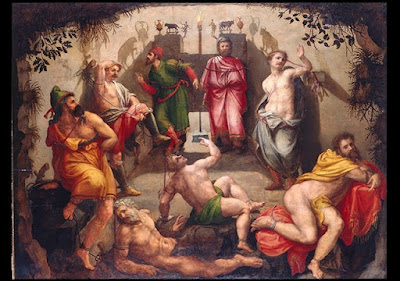Plato's Allegory of the Cave
In Plato's allegory of the cave, a number of prisoners have been imprisoned since childhood in a cave, chained so they cannot move, nor turn their heads, so that all they can see before them are shadows on a wall, and all they can hear are echoes around the cave's walls, that they take to be coming from the shadows. These shadows and echoes they take to be real, for they have known only these.
Let us say that one prisoner manages to break free from his shackles and looks around. He sees now that behind the prisoners is a raised walkway with a low wall, and that behind that is a bright fire. He notices that people walk behind the wall so that they do not cast shadows from the light of the fire, and that they hold aloft objects or puppets of men and other living things. It is these that cast shadows against the cave wall in front of the prisoners, and which the prisoners have taken to be real, just as they have mistaken the echoing voices of the puppeteers to be emanating from the shadow puppets.
